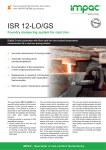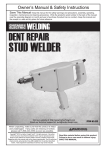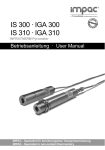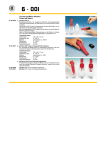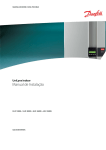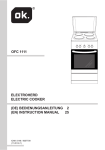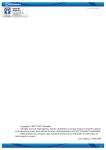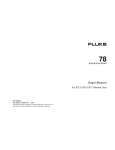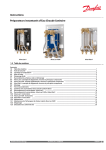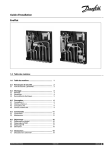Download User Manual
Transcript
User Manual Infratherm Pyrometer IN 5 · IN 5/5 Contika Hindhøjen 82 8382 Hinnerup www.contika.dk Contents 1. Scope of delivery.......................................................................................................................18 2. Equipment directory Infratherm IN 5; IN 5/5.............................................................................18 3. Optics ........................................................................................................................................19 4. Technology................................................................................................................................20 4.1. Technical description...........................................................................................................20 4.2. Technical data.....................................................................................................................21 5. Instrument settings...................................................................................................................22 5.1. Controls...............................................................................................................................22 5.2. Emissivity (EMI)...................................................................................................................22 5.2.1. Explanation.............................................................................................................22 5.2.2. Emissivities of common materials............................................................................23 5.2.3. Set up examples for IN 5; IN 5/5.............................................................................23 5.3. Response time t90 ................................................................................................................23 6. Electrical installation ................................................................................................................24 6.1. Connector assignment.........................................................................................................24 6.2. Display devices ...................................................................................................................24 6.3. Connection schematic for display devices............................................................................24 6.4. Examples for the IN 5 with peripheral devices......................................................................25 7. Mechanical installation .............................................................................................................25 7.1. Davice dimensions IN 5; IN 5/5...........................................................................................25 7.2. Adjustable mounting support with 2 axes .............................................................................26 7.3. Water cooling jacket / Air purge ...........................................................................................26 7.4. Water cooling jacket (heavy duty) with integrated air purge ..................................................27 7.5. Mounting tube .....................................................................................................................27 7.6. Flange tube .........................................................................................................................27 7.7. Vacuum flange ....................................................................................................................28 7.8. Avoiding reading errors caused by faulty assembly..............................................................28 8. Order numbers for IN 5 und IN 5/5 instruments incl. optics....................................................28 8.1. Ordering example for IN 5....................................................................................................38 8.2. Accessories.........................................................................................................................39 8.2.1. Mechanical accessories ..........................................................................................39 8.2.2. Electrical accessories..............................................................................................39 9. Further information...................................................................................................................30 9.1. Maintenance........................................................................................................................30 9.2. Packing instructions.............................................................................................................30 9.3. Warranty .............................................................................................................................30 9.4. Limit of Liability....................................................................................................................30 9.5. Copyright.............................................................................................................................30 10. Glossary ....................................................................................................................................31 11. Subject index ............................................................................................................................33 17 Congratulations on choosing the IMPAC pyrometer. You are now the owner of a compact infrared non-contact thermometer, which combines efficiency and excellence for optimal temperature measurements. Please read this manual carefully before installing this pyrometer. It contains all the necessary information to set up and operate the new IMPAC pyrometer. Should you require further assistance, please call our customer service hotline in Germany (+49) (0) 69 9 73 73-190. IMPAC has been developing and manufacturing non-contact temperature measurement instruments since 1958 and has more than 60 000 pyrometers and systems installed worldwide. IMPAC Electronic GmbH 1. Scope of delivery − Pyrometer with optics (IN 5: a = 100, 300 or 800 mm. IN 5/5: a = 100, 300 or 1200 mm) Please Note: A connecting cable is not included with the instrument and should be ordered separately (see 8. Order numbers). 2. Special features Infratherm IN 5; IN 5/5 − Suitable for measuring objects with non-metallic surfaces (IN 5) and metals which are painted or oxidised or glass surfaces (IN 5/5) − Measures temperature ranges between -32 and 900 °C (IN 5); between 100 and 2500 °C (IN 5/5) − Two wire technique − Analog output 4 - 20 mA − Digital linearization guarantees accuracy up to 0.6 % of the measured value − Readings are unaffected by the relative humidity or the amount of CO2 in the air − Stainless steel housing − Adjustable emissivity from 0.20 to 1.00 (20 - 100 %) in 0.01 (1 %) steps − Adjustable response time from 0.08 to 5 sec Safety warning: Caution! Do not clean the lens with liquids containing acids or solvents 18 3. Optics The pyrometer is available with various optical profiles. Select the optics that are most appropriate for your application from the optical profiles shown below. The optics must be chosen when ordering the instrument, and cannot be changed once installed. A pyrometer operates passively. It receives heat radiation, from the measured object, which passes through the lens and is then converted to an electrical signal. The measured object may be at any distance from the pyrometer! However, the farther the measured object is from the pyrometer, the larger the area (spot size) that will be measured by the pyrometer. The object (or the area on the object) that you want to measure has to be as big (or bigger) than the pyrometer's spot size, for that distance. The following drawings show the pyrometer's spot sizes (minimum required sizes for the measured object) and the focal distances, in relation to the distance from the pyrometer. The spot size at a distance of 0 mm (a = 0) is 15 mm (M = 15) or 10 mm (M = 10 at the IN5/5, MB 25), which is the diameter of the aperture behind the lens. Distance a [mm] 0 200 100 300 IN 5; Optics 100 Spot size M [mm] Distance a [mm] 2 15 0 300 15 6 18 600 35 1000 IN 5; Optics 300 Spot size M [mm] 22 45 2500 Distance a [mm] 0 800 15 16 1500 IN 5; Optics 800 Spot size M [mm] 36 68 Distance a [mm] 0 100 200 300 IN 5/5; Optics 100 Spot size M [mm] Distance a [mm] 2,5 15 (10)* 300 0 18 (13)* 35 (24)* 1000 600 IN 5/5; Optics 300 Spot size M [mm] Distance a [mm] 15 (10)* 6 1200 0 22 (17)* 2500 45 (32)* 4000 IN 5/5; Optics 1200 Spot size M [mm] 15 (10)* 24 50 (43)* 80 (65)* * MB 25 at the IN 5/5 Note: Please note that the optical profiles show nominal dimensions. The spot size diameter or the focal distance may be slightly different due to lens tolerances. 19 The optical profiles show that the spot size M varies with the distance from the pyrometer. Spot sizes for intermediate distances, that are not shown on the optical profiles, may be calculated using the following formula, where: D = 15 mm (10 mm at IN 5/5, MB 25) (the aperture diameter) a = the nominal distance (from the optical profiles ) M = the nominal spot size (from the optical profiles) M2 = a2 (M − D )+ D a M1 = a1 (M + D )− D a a1 a a 2 Ø M2 Ø M1 ØM ØD 4. Technology 4.1. Technical description All objects whose temperature are above absolute zero (-273.15 ºC / -459.67 ºF) emit heat. Most of this heat is emitted as infrared (IR) radiation. IMPAC pyrometers are measuring instruments, which receive heat radiation through the optics and focus it on a detector. The detector converts it into an electric signal. This signal is digitally linearized and converted into a standard analog output signal. For best accuracy, the correct optical filter with the appropriate spectral range must be selected for the the type of material that is being measured. For example, select the IN 5 with the 8 to 14 µm spectral range for measuring non-metallic surfaces or the IN 5/5 with the narrow 5.14 µm nominal bandwidth for measuring glass surfaces. An integrated micro-controller performs all calculations and digital processing. 20 4.2. Technical data Temperature ranges: IN 5: 0 to 100 °C 0 to 200 °C 0 to 300 °C 0 to 400 °C 0 to 500 °C 0 to 900 °C - 32 to + 50 °C IN 5/5: 100 to 600 °C 200 to 800 °C 100 to 1300 °C 400 to 2500 °C (custom temperature ranges for either instrument are available on request) Data handling: Digital Spectral response: IN 5: IN 5/5: 8 to 14 µm 5.14 µm (for all general applications on non-metallic surfaces and metals which are painted or oxidised) (narrow band, for glass surfaces) Optics: IN 5: Germanium (Ge) Lens IN 5/5: Zinc Sulfide (ZnS) Lens IR-detector: Silicon (Si)-based thermopile Power supply: 24 V DC (10 to 30V) ripple must be less than 0.5 V Analog output: 4 - 20 mA, direct current, linear resolution: 2880 steps Load: max. 700 Ω at 24 V (max. 100 Ω at 12 V) Emissivity: user-adjustable from 0.20 - 1.00 in steps of 0.01 Response time t90: user-adjustable from 0.08 to 5 sec Accuracy: IN 5 Tu 15 to 30 °C 0 to 15 °C or Dependent on object temperaT 30 to 63 °C ture T and ambient tempera0 to 300 °C 0.6 % of measured value 1 % of measured value in ture Tu ) ) in °C or 1 °C ∗ °C or 1.5 °C ∗ (ε = 1, t90 = 1 sec): 300 to 900 °C 1 % of measured value 1.3 % of measured value in °C in °C -32 to 0 °C 1.5 °C 2 °C IN 5/5 Tu 15 to 30 °C 0 to 15 °C or T 30 to 63 °C 100 to 1300°C 0.6 % of measured value 1 % of measured value in ) ) in °C or 2 °C ∗ °C or 3 °C ∗ 1300 to 1800°C 0.8 % of measured value 1.2 % of measured value in °C in °C 1800 to 2500°C 1 % of measured value 1.4 % of measured value in °C in °C ∗) whichever value is greater. The instrument must be at a constant ambient temperature for a minimum of 15 minutes 21 Repeatability: IN 5; IN 5/5: ∗) 0.3 % of measured value in °C or 0.6 °C ∗ ) whichever value is greater. The instrument must be at a constant ambient temperature for a minimum of 15 minutes Noise Equivalent Temperature 0.2 K (σ = 1) measured temperature = 23 °C, t90 = 80 ms and ε = 1 Difference (NETD): 0.05 K (σ = 1) measured temperature = 23 °C, t90 = 1 sec and ε = 1 Ambient temperature: 0 to +70 °C (IN 5/5, MB 25: 0 to 63 °C) Storage temperature: -20 to +70 °C Enclosure rating: IP 65 (DIN 40050) Weight: 400 g Dimensions: 111 mm x 49,5 mm (l x d) Housing: Stainless steel Operating position: Any CE Approval / EMV tests: Satisfies EU regulations for electromagnetic immunity (industry norm) 5. Instrument settings 5.1. Controls The controls are located under the rear cover of the pyrometer and can be accessed by removing the rear cover. To remove the rear cover unscrew both rear screws and take the cover off, making sure it remains straight (without bending or twisting it). Caution: Disconnect the cable before opening the cover. Reconnect only when assembly is complete! When reassembling the cover, insert it carefully into the guide pins and then fasten it with the screws. The connector cable can now be plugged in. 5.2. Emissivity (EMI) 5.2.1. Explanation The temperature of a given object can only be measured correctly if its exact emissivity ε (Epsilon) is known and the pyrometer is set up accordingly. The emissivity is the ratio between the level of radiation from an object and the level of radiation from a black body radiator at the same temperature. Different materials have different emissivities ranging between 0 and 1.00 (or 0% and 100% ). A value of ε = 1 means that the material absorbs all incoming radiation acting like a black body (a perfect absorber and perfect emitter). Materials which reflect more radiation have a lower emissivity and the emissivity control of the pyrometer needs to be adjusted accordingly. Emissivity values of common materials are listed in table 5.2.2. Emissivities of common materials. Note: The minimum emissivity setting for the pyrometer is 0.20 (20 %)! One way to determine an accurate emissivity value for a material is to make a comparison measurement. This can be done as follows: 22 1. Measure the surface temperature of the object using a contact thermometer (e.g. Tastotherm MP2000 with a suitable probe) and, at the same time, measure the temperature using the pyrometer. Adjust the emissivity control until the pyrometer displays the same temperature as the thermometer. 2. If possible, coat a portion of the object with dull black paint or carbon soot. Paint and carbon soot have high emissivities (0.95) and take on the same temperature as the object. Measure the temperature of the painted area with the emissivity control set to 95 %. Then measure the temperature of an adjacent unpainted area of the object and adjust the emissivity until the pyrometer displays the same temperature. 5.2.2. Emissivities of common materials Object ε (at 8 to 14 µm) Object "Black body furnace" Human skin Black dull varnish Carbon soot Wood Paper Asphalt Glass/Quartz glass Textile Graphite Cement Water 1.00 0.98 0.95 0.95 0.8 - 0.92 0.92 - 0.95 0.85 0.72 - 0.87 0.75 - 0.95 0.75 - 0.92 0.9 0.95 Brickwork Fire clay Rubber Porcelain Ceramics Varnish Plaster Oil paint Steel (oxidized) Steel (smooth) Aluminium (smooth) Aluminium (anodized) Object ε (at 5.14 µm) Glass/Quartz glass 0.97 ε (at 8 to 14 µm) 0.85 - 0.95 0.6 - 0.8 0.1 - 0.3 0.02 - 0.15 0.9 5.2.3. Set up examples for IN 5; IN 5/5 ε = 1.00 Adjust both switches (EMI) as shown in the example on the left. ε = 0.85 Emissivity ε can be adjusted between 0.20 and 1.00 in steps of 0.01. Note: If the emissivity is set to a value below 0.2 the instrument will automatically utilize an emissivity value of 1. The setting 00 is interpreted as ε = 1.00! 5.3. Response time t90 The response time t90 is the time interval from the start of measurement up to the respective change in the output signal (4 - 20 mA) which is the time taken to reach 90 % of the recorded temperature difference. The response time is changed by adjusting the jumper position. In the open position shown in the diagram on the left, the response time is 0,08 s. For alternative settings (t90 = 0,5 s, 1 s, 2 s or 5 s) select the respective jumper position (see diagram on Example: t90 = 0,5 s Example: t90 = 0,08 s the right). Longer response times are useful when measuring objects with fluctuating temperatures. Settings at delivery: ε = 1; t90 = 0.08 s 23 6. Electrical installation The Infratherm IN 5 and IN 5/5 is powered by 24 V DC (10 to 30 V DC). When connecting the device to the power supply ensure correct polarity. The power consumption (in this case 4 - 20 mA) is also the measuring signal. To meet the electromagnetic requirements (EMV), a shielded connecting cable must be used. The shield of the two wire connecting cable is usually only connected on the pyrometer side. If the connecting cable is extended, the extension cable also needs to be shielded. Do not connect the shield to the power source side (control cabinet), to avoid ground loops. 6.1. Connector assignment Pyrometer plug (connector): 3 pole Flange plug 2 1 3 Pin 1 (white) +24 V (10 V to 30 V) Pin 2 (brown) 0V Pin 3 (black) shield 6.2. Display devices To display the temperature, IMPAC offers display devices with integrated power supplies for two-wire pyrometers as accessories. (see 8. Order numbers) • • • (DA 4000-N): display only (DA 4000): DA 4000-N with 2 limit switches (DA 6000): With 2 limit switches, maximum value storage and R S232 or RS 485 interface display device type DA 4000 6.3. Connection schematic for display devices The DA 4000, DA 4000-N and DA 6000 LED display devices have an integrated 24 V power supply for twowire instruments. If an RS 232 interface is required then the DA 6000 display must be used. 230 V ~ + + white IN 5 – brown LED-digital display with integrated power supply recorder 4 ... 20 mA -+ controller + 24 6.3.1. Examples of the IN 5 with peripheral devices 24 V DC + - + wt IN 5 - br + 230 V ~ PL C - + + wt IN 5 - br + PL C IN 5 – brown + wt IN 5 - br + white DIN rail power supply - 24 V DC - - + + Separate current output (e.g. to a computer) Galvanic separator + PL C - Note: Additional instruments with current input e.g. a recorder (see 8. Order numbers) or a controller can be connected to the display in series as shown above. 7. Mechanical installation 7.1. Device dimensions IN 5; IN 5/5 7 24.5 104.5 6.5 Robust mounting accessories for installation of the Infratherm IN 5 or IN 5/5 are described and depicted in the following section, along with the article numbers (see also 8.2.1. Mechanical accessories). 25 7.2. Adjustable mounting support with 2 axes Pyrometer The standard mounting support is made from stainless steel. It can be independently adjusted in the horizontal or vertical directions (± 45º). Note: This mounting support cannot be used with the water cooling jacket. Mounting support 7.3. Water cooling jacket (standard) / Air purge The standard water cooling jacket is designed to protect the pyrometer in hot environments with ambient temperatures above 70 °C (or 63 °C at the IN 5/5, MB 25). With this cooling jacket, the pyrometer may be operated at ambient temperatures up to 170 °C when using a cooling water temperature of 17 °C and a cooling water flow rate of 0.4 l/min. The air purge protects the lens of the pyrometer against dust, humidity and other suspended matters by blowing air away from the lens in a cone-shaped air stream. Wall Mounting flange Connecting flange (or mounting angle) Rear wall (optional) Water cooling jacket Air purge (or mounting socket) Note: Both parts are also available separately! Mounting instructions: Depending on intended use, additional parts may necessary for proper mounting: • The water cooling jacket requires an attachment device such as: - a mounting flange with air purge or mounting socket (not in drawing) and connecting flange. - or a mounting angle with air purge or mounting socket. (The air purge can also be used alone in connection with the pyrometer.) • The mounting flange can be used instead of the connecting flange (or mounting angle); the mounting angle can also be used instead of the mounting flange. • The rear cover (with cable duct) serves as an additional temperature protection. 26 7.4. Water cooling jacket (heavy duty) with integrated air purge Air 8 mm The heavy duty water cooling jacket protects the pyrometer in extremely hot ambient temperatures. It is completely closed and is equipped with a long air purge tube to protect the lens. With the heavy duty cooling jacket, the pyrometer may be operated at ambient temperatures up to 280 °C when using a cooling water temperature of 14 °C and a cooling water flow rate of 2 l/min. Max. water pressure is 6 bar. Note: Water 8 mm Mounting wall Water 8 mm The maximum possible ambient temperature is dependant on the temperature and flow rate of the cooling water. All maximum temperatures stated are for reference and need to be verified according to the specific conditions. Ensure that the cooling water is at the correct temperature at all times. If the cooling water is too cold, condensation can build up inside the device, which will prevent proper functioning of the pyrometer. When using the pyrometer in very low ambient temperatures, proper operation can be achieved by using heated throughput water. Note on air purge: The required airflow rate is approximately 25 - 30 l/min (1.5 - 1.8 m³/h) at approx. 0.2 - 0.5 bar. Please use clean, dry air (oil and dust free) only! 7.5. Mounting tube The mounting tube protects the lens of the pyrometer from dirt. There is also an 8 mm diameter connector. plastic protection cap Air connector 8 mm 7.6. Flange tube The flange tube is a mounting tube with a weldable flange. plastic protection cap Air connector 8 mm Note on mounting tube: The air volume required for the mounting tube is approximately 50 - 60 l/min (3.0 - 3.6 m³/h) at approx. 0.4 - 1 bar. 27 7.7. Vacuum flange The vacuum flange separates the pyrometer from the process area. The pyrometer can be easily removed, without an interruption to the process (furnace or vacuum). The decrease in radiation, due to the window’s transmission, can be compensated by reducing the emissivity setting by the appropriate factor. Window material: KF16 Vacuum flange KF 16 Pyrometer Fenster • IN5: ZnSe Transmission: 71 % • IN 5/5: CaF2 Transmission: 94 % 7.8. Avoiding reading errors caused by faulty assembly To avoid reading errors, please note the following points when mounting the pyrometer: 1. The diameter of the measuring object cannot be smaller than the pyrometer’s spot size (see 3. Optics). 2. A source of radiation behind or around the measuring object can influence the result. If the object is transparent or partly transparent another material behind the object could transmit its radiation to the pyrometer as well. In this case the location of the pyrometer should be changed, or, if the background radiation remains constant it can be compensated for by changing the emissivity setting respectively. 3. Please take into account that radiation from other hot parts around the measured object can be reflected by it and influence the result. If the measured object has a low emissivity, the temperature measured will be mainly that of the reflected object not from the intended measured object itself. To prevent environmental radiation from reaching the spot area, a mounting tube should be used. The mounting tube should be placed as near as possible to the measured object so that the tube’s shadow blocks out all the environmental radiation. 8. Order numbers for IN 5 or IN 5/5 instruments incl. optics Order numbers IN 5 8 to 14 µm 3 869 010 3 869 020 3 869 030 3 869 040 3 869 050 3 869 090 3 869 100 Messbereich 0 to 100 °C 0 to 200 °C 0 to 300 °C 0 to 400 °C 0 to 500 °C 0 to 900 °C - 32 to + 50 °C Order numbers IN 5/5 5.14 µm 3 869 110 3 869 120 3 869 130 3 869 140 Messbereich 100 to 600 °C 200 to 800 °C 100 to 1300 °C 400 to 2500 °C Custom ranges available upon on request. The optics must be specified when ordering IN 5: a = 100, 300 or 800 mm; IN 5/5: a = 100, 300 or 1200 mm Note: The length of the measuring area does not affect the accuracy of the pyrometer, but does affect the resolution of the analog output (2880 steps for the range 4 - 20 mA). 8.1. Ordering example for IN 5 3 869 040 3 820 560 28 IN 5, Temperature range 0 to 400 °C Optics a = 300 mm Connecting cable 5 m length 8.2. Accessories 8.2.1. Mechanical accessories: Order No.: Accessory: 3 834 210 Mounting bracket (adjustable) 3 835 160 Air purge Water cooling system (combination): 3 837 080 Standard water cooling jacket for ambient temperatures up to 170 °C 3 846 100 Mounting tube 3 835 080 Mounting angle 3 835 070 Connecting flange 3 835 160 Air purge 3 835 090 mounting socket 3 835 110 Rear wall for cooling jacket 3 837 230 3 846 120 3 846 620 3 846 630 3 846 650 3 846 660 Water cooling jacket (heavy duty) with integrated air purge for ambient temperatures up to 280 °C Flange tube Vacuum flange KF16 with CaF2–window for IN 5/5 Vacuum flange KF16 with ZnSe-window for IN 5 Spare window CaF2 Ø 25x3 with Viton-O-ring Spare window ZnSe Ø 25x3 with Viton-O-ring 8.2.2. Electrical Accessories: Order No.: 3 820 210 3 820 560 3 820 570 3 820 580 3 820 590 3 820 280 3 890 600 3 890 960 3 890 610 3 890 640 3 890 650 3 890 520 3 890 530 3 890 660 3 863 010 Accessory: Connection cable 2 m long Connection cable 5 m long Connection cable 10 m long Connection cable 15 m long Connection cable 30 m long Connection cable 2 m long, temperature resistant up to 200 °C, (Silicone) Power supply for DIN rail mounting (230 V AC into 24 V DC) Power supply for DIN rail mounting (115 V AC into 24 V DC) Galvanic separator for DIN rail mounting (no extra power supply necessary) DA 4000-N: LED-Digital display with integrated 2 wire supply DA 4000: like DA 4000-N, but additionally with 2 limit switches DA 6000: analog input and 2 limit switches, RS 232-interface DA 6000: analog input and 2 limit switches, RS 485-interface IP 65-front cover for LED digital display Converter IW 5-C (4 - 20 mA into 0 - 20 mA) 29 9. Further information 9.1. Maintenance The pyrometer has no internal parts which have to be cleaned. The lens can be cleaned with compressed air which is dry and free of oil. If the lens requires more thorough cleaning, use a soft, dry cloth such as that used to clean camera objectives. Caution: Do not clean or touch the lens with acidic or solvent liquids! The Ge lens of the IN 5 has an anti-reflective coating which appears slightly colored. Be extremely careful - this layer can easily be rubbed off - this will greatly affect the measuring results! 9.2. Packing instructions To transport or store the instrument, please use the original box or a box padded with sufficient shockabsorbing material. For storage in humid areas or shipment overseas, the device should be placed in welded foil (ideally along with silicon gel) to protect it from humidity . 9.3. Warranty All series 5 instruments from IMPAC Electronic GmbH have a warranty of two years from the invoice date. This warranty covers manufacturing defects and faults which arise during operation only if they are the result of defects caused by IMPAC Electronic GmbH. User-induced faults are not covered with this warranty. 9.4 Limit of Liability IMPAC Electronic GmbH is not liable for any damages that arise from the use of any examples or processes mentioned in this manual. 9.4. Copyright All copyrights reserved. This document may not be copied or published, in part or whole, without the prior written permission of IMPAC Electronic GmbH. 30 10. Glossary Absolute zero -273.15°C (-459.67 ºF), lowest possible natural temperature. No molecular activity occurs. Absorption Transfer of energy to a material by means of wave radiation or particle radiation. Reception of energy (light, heat), gases or liquids. Air purge Accessory to keep dust and dirt away from the optics Aperture Optical diameter of the stop of an objective Black body A body that absorbs all incoming radiation at all wavelengths and that emits the maximum possible radiation at all wavelengths for its temperature (has an emissivity value of 1 at all wavelengths) Black body furnace Radiates almost like an ideal black body. Needed for calibrating and testing infrared pyrometers Calibration Comparison of the pyrometer to international temperature standards and adjustment so that it measures accurately in accordance to the temperature standards Certificate Document on the conformity of the calibration accuracy Contact thermometer Temperature measuring device which measures an object’s temperature by contact, for example thermocouples or resistance thermometers Cooling jacket Accessory for using the pyrometer at high ambient temperatures Detector Receptor for radiation. Changes heat radiation into an electrical signal Emissivity Ratio of the radiation emitted by a surface to that emitted by a black body at the same temperature Infrared (IR) Electromagnetic waves that are invisible and have longer wavelengths than red light in the visible spectrum. Wavelengths between 0.78 and 1000 µm. Instrument temperature Automatic compensation for the temperature change of the pyrometer due to a compensation change in the ambient temperature Interface RS 232, RS 485, digital output for communication between pyrometer and computer or bus Lens tolerance Production-determined spread of focal length and centering Limit switches Relays that switch at predefined temperatures. i.e. high/low alarm ( located in the power supply or digital display ) Linearization A function of the signal processing performed by the microprocessor in a pyrometer. Establishes the proportionality between the measured temperature and the output signal Maximum measuring range limit Upper limit of the measuring range (highest measurable temperature for the pyrometer) 31 Minimum measuring range limit Lower limit of the measuring range (lowest measurable temperature for the pyrometer) Measuring distance Distance between the measured object and the lens of the pyrometer Measuring uncertainty Most probable deviation between displayed and true temperature Objective Optical system which consists of lenses or mirrors and which forms the object’s image on the detector of the pyrometer Pyrometer Instrument for non-contact temperature measurement (radiation thermometer) Rate of reflection Ratio of reflected intensity to incident intensity Reflection Return of radiation rays at the border between two materials, may be directed or diffuse Repeatability The uncertainty with which a measured value may be reproduced under constant conditions (same instrument, same environmental conditions) Soot black carbon in powder form (residue of incomplete burning of organic substances) has very high emissivity Spectral range The wavelength range within the electromagnetic spectrum used by the pyrometer Spectrometer Measuring device which determines the radiation intensity in relation to the wavelength Spot size Area on the object from which the pyrometer receives the temperature radiation Temperature Corresponds to the average molecular velocity inside the material, measured in Kelvin, °Celsius or °Fahrenheit K = °C + 273.15 °C = 0.555 (°F - 32) °F = 1.8 °C + 32 Test certificate Certificate stating the accuracy of a measuring device in relation to known standards Wavelength Property of electromagnetic waves, corresponding to the color of light for the visible part of the electromagnetic radiation Window Special glass plate, for protection of the pyrometer against hazardous materials, which allows the pyrometer to measure a process (through the window) 32 11. Subject index A______________________________________ Accessories .................................................... 29 Accuracy ........................................................ 21 Air connector...............................................26/27 Air flow rate .................................................... 27 Air purge ....................................................26/27 Ambient temperature ..................................26/27 Aperture.......................................................... 19 Assembly, faulty ............................................. 28 B______________________________________ Black body radiator ......................................... 22 C______________________________________ Connecting cable ........................................18/22 Connecting flange .......................................... 26 Connection examples...................................... 25 Connection for display devices ........................ 24 Connection schematic ..................................... 24 Connector assignment .................................... 24 Contact thermometer ...................................... 23 Controls .......................................................... 22 Cooling jacket ............................................26/27 Copyright ........................................................ 30 D______________________________________ DA 4000/DA 6000 ........................................... 24 Dimensions .................................................... 25 Direct current ................................................. 24 Display devices ............................................... 24 Distance ......................................................... 19 E______________________________________ Electrical accessories...................................... 29 Electrical installation........................................ 24 Emissivities of common materials.................... 23 Emissivity........................................................ 22 Equipment directory ........................................ 18 Explanation ..................................................... 22 F______________________________________ Faulty assembly .............................................. 28 Flange tube .................................................... 28 Further Information.......................................... 30 G______________________________________ Glossary......................................................13/32 L______________________________________ Lens tolerances............................................... 19 Lens................................................................ 30 Limit of Liability................................................ 30 M______________________________________ Maintenance ................................................... 30 Materials ......................................................... 23 Mechanical accessories .................................. 29 Mechanical installation .................................... 25 Mounting support ............................................ 26 Mounting tube ................................................ 27 O______________________________________ Optics.............................................................. 19 Order numbers ............................................... 29 Ordering example ........................................... 28 P______________________________________ Packing instructions......................................... 30 Polarity............................................................ 24 Power consumption......................................... 24 R______________________________________ Reading errors ................................................ 28 Response time ............................................... 23 S______________________________________ Safety warning ............................................... 18 Scope of delivery ............................................ 18 Set up examples.............................................. 23 Settings at delivery .......................................... 23 Shielding ......................................................... 24 Signal ............................................................. 24 Spot size ........................................................ 19 Switches ......................................................... 23 Switches ......................................................... 23 T______________________________________ Technical data............................................ 21/22 Technology .................................................... 20 Transmission................................................... 28 Two wire principle ........................................... 24 V______________________________________ Vacuum flange ................................................ 29 W______________________________________ Warranty ........................................................ 30 Water cooling jacket ................................... 26/27 Wavelength .................................................... 20 33 IMPAC Electronic GmbH Temperaturmessgeräte Krifteler Str. 32 D - 60326 Frankfurt/Main Tel.: +49-(0)69-9 73 73-0 Fax: +49-(0)69-9 73 73-167 Internet: www.ir-impac.com E-Mail: [email protected] 3 869 018-B



















